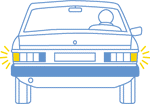|
Warn other drivers of an obstruction by switching on the four-way hazard warning lights. Ensure that nothing blocks the hazard warning lights from the sight of other drivers. If necessary, switch on other lights or use any other means of warning approaching traffic. If you have a red warning triangle, display it at a suitable place behind your vehicle to warn other drivers (see this page). When the obstruction is cleared, do not forget to remove any warning signs/ objects placed on the road. However, on expressways or roads with fast traffic (speed limit exceeding 50 km/h), do not attempt to place a warning triangle or any warning objects on the carriageway as it is a dangerous action and the objects placed may pose danger to other road users. Just switch on your hazard warning lights. Hazard warning lights
As a safety practice, you may also turn on the hazard warning lights when your vehicle is likely to be a hazard to other road users (e.g. when parking, carrying out temporary loading/unloading, or making sudden deceleration because of |
|
Warning triangles |
|
 |
Carry a suitable warning triangle for use in an emergency or when your vehicle breaks down on roads with speed limit up to 50 km/h to warn other drivers of your vehicleʼs presence or other obstruction. The triangle should have a red reflective or fluorescent surface so that it can be easily seen in all conditions. |
 |
If your vehicle could be an obstruction to traffic, under safe conditions, stand the warning triangle on the road, preferably in the same lane, at about 50 metres before the obstruction and on the same side of the road (see the diagram on the left). Always walk behind the roadside crash barriers, if available. If the road is not straight or level, stand the warning triangle where an oncoming driver will see it before coming to any bend or brow of a hill. However, if it is not safe for you to do so, place the triangle nearer the vehicle. When the obstruction is cleared, do not forget to remove the warning triangle. |
 You must turn on the hazard warning lights if your vehicle is stationary on an expressway or a road with a speed limit exceeding 50 km/h because of a breakdown or an emergency to warn other drivers of your presence.
You must turn on the hazard warning lights if your vehicle is stationary on an expressway or a road with a speed limit exceeding 50 km/h because of a breakdown or an emergency to warn other drivers of your presence.